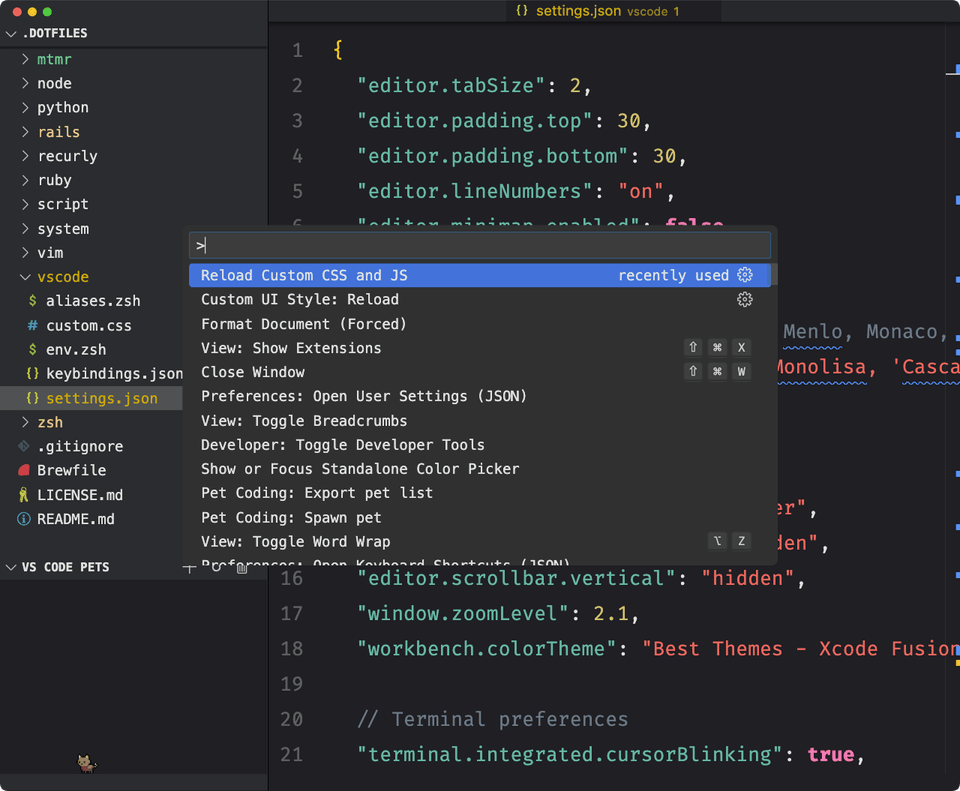Make VS Code spark joy
— dev, english, dev-tools — 3 min read
Today I'll show you a straightforward method for theme elements on your VS Code using CSS. To unlock this we will install an extensions that inject CSS into the editor.
How cool is using a piece of software that feels like home?
Customizations like theming and shortcut preferences may sound useless at first, but they're the kind of things that spark joy and empowers productivity.
An editor is a software that we use regularly in our daily basis. So for me, every effort in increasing appeal and making navigation easy is something that is worth doing.
Embrace the command palette
Some of us might find mouse movement tedious and slow. Developers huh? Fortunately, there are shortcuts for faster and simple way to access things.
One of my favorite is the command palette and you can open it with
cmd + shift + P. From the modal that opens, start typing for search the
command you want to execute. A shortcut for other shortcuts, if you will. For
example, open the command palette, type "devtools" and select
Developer: Toggle Developer Tools.
DevTools in the editor? Is this real life?
Now we can inspect the command palette modal CSS identifier. With the
DevTools open on the elements tab, open the command palette and check for the
CSS identifier (it's .quick-input-widget, by the way).
I had preferences once
By default, the process of theming is either editing the setting.json file
and keybindings.json (for shortcut preferences) or installing theme focused
extensions.
That's fine for many cases, but there are parts of the VS Code interface that aren't accessible through these methods.
To do this, we use extensions that allow us to modify VS Code's CSS elements and unlock more customization options!
Adding custom CSS
Now search and install for the Custom CSS and JS Loader extension.
Create a custom.css file anywhere you want, and reference that in your
settings.json like this:
"vscode_custom_css.imports": ["file:///absolute/path/to/custom.css"],The custom.css file is the place to add your styles. For example, add the
following:
.quick-input-widget { top: 50% !important; left: 50% !important; transform: translate(-50%, -50%) !important; box-shadow: none !important;}Because we've changed some styles, we need to reload the extension. Open the command palette and select Reload Custom CSS and JS and then restart VS Code.
Now our command palette modal always appears centered! 🎉

The idea for this post came with a sudden desire to make my VS Code more minimal for my eyes. I ended up changing a whole bunch of things that I wouldn't bother you with all the details.
But feel free to check out my VS Code settings for inspiration.
GitHub recent absorption by Micro$oft
The announcement raised some red flags in my head. One concern is that my code in VS Code might be used to train AI or that Copilot could be violating popular open-source licenses without my consent. And secondly, it reminds me not to rely too much on popular software we don’t own and use every day. But those are topics for another post.
How cool is using a piece of software that feels like home?
Wait, I've already said that. 😛
Thank you for reading!
Want to help me? Beyond my formal work and freelancing, I've never made a penny from my content. But hey, anything I've shared ever helped you out or wanna keep me excited on sharing cool stuffs? Consider buying me a coffee or supporting me on Ko-fi.